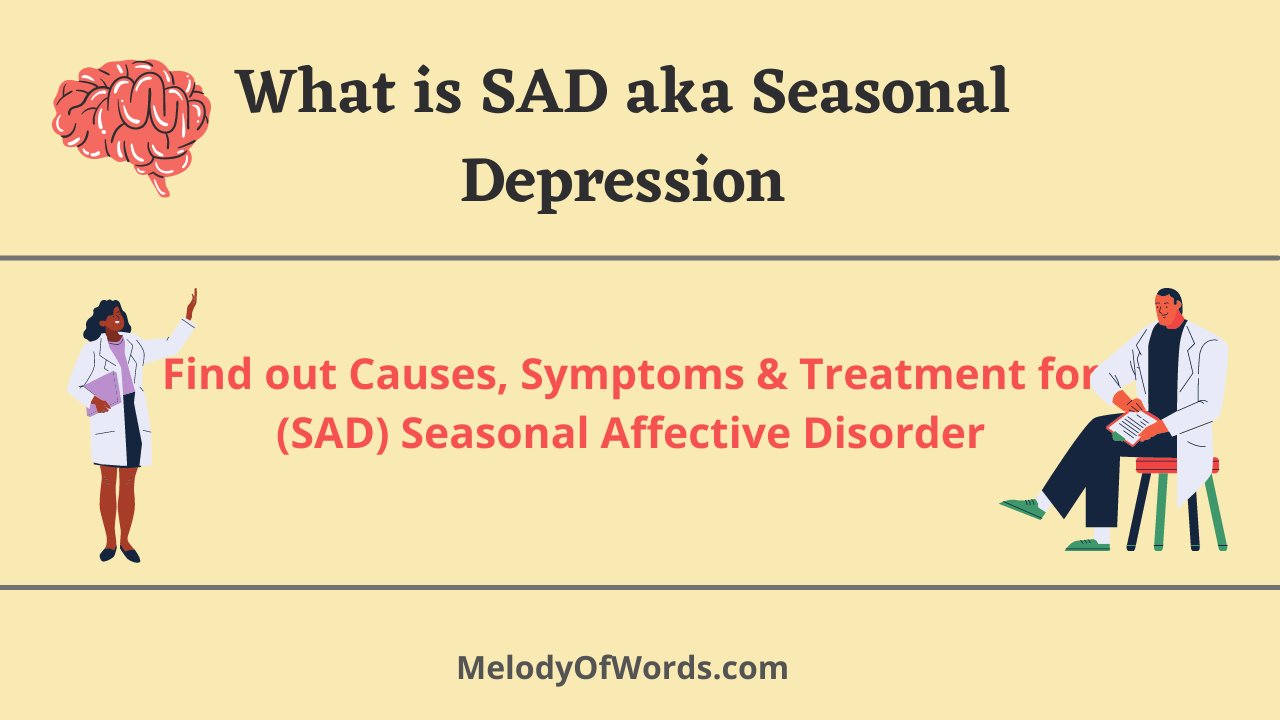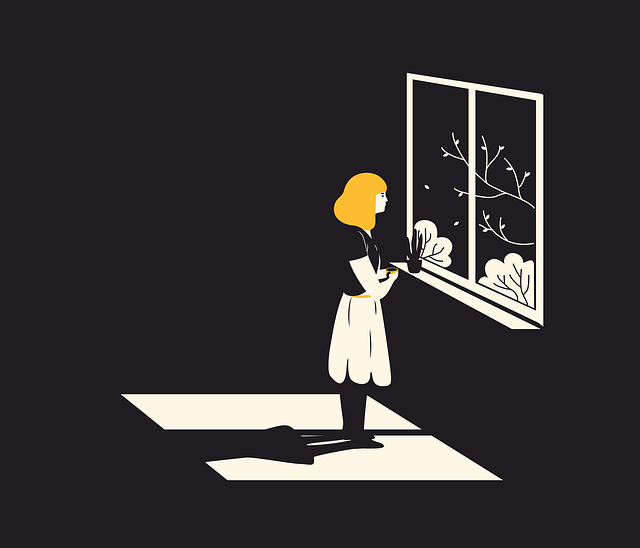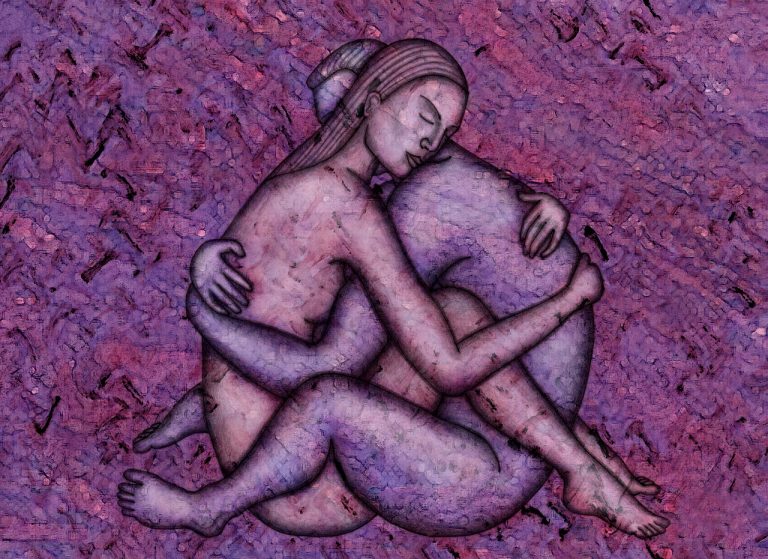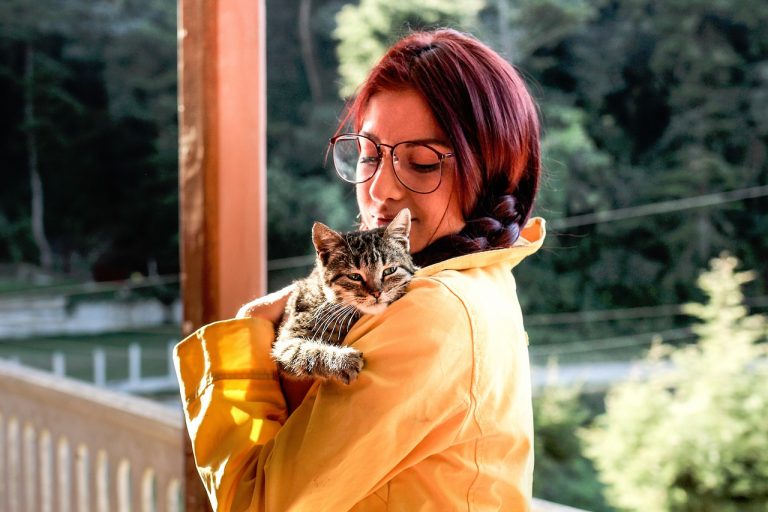What is SAD aka Seasonal Depression: Find out Causes, Symptoms and Treatment for (SAD) Seasonal Affective Disorder

Seasonal Affective Disorder (SAD) is a form of depression generally known, and referred to as Seasonal Depression or Winter Depression.
The syndrome was first described by Dr. Norman E. Rosenthal, a psychiatrist, and researcher, who did an extensive study on SAD.
Now you might be curious why we call SAD Seasonal Depression? and the reason won’t astound you. Because SAD aka Seasonal Depression gets activated when the seasons change, and it begins and ends at the same time every year.
Those who deal with Seasonal Affective Disorder observe changes in their mood, loss of appetite, and decreased energy levels are a few of its common symptoms. People with SAD often feel anxious, stressed out, hopeless, and irritable at that particular season or time of the month.

Seasonal Affective Disorder is also known as Winter Depression, know why:
Dr. Rosenthal with his colleagues first mentioned the syndrome of SAD or Winter Depression in an article published in 1984. The basis of their research was the data, they collected from a group of people living in Maryland, U.S. who experienced major depressive symptoms in particular seasons.
In his research, Dr. Rosenthal found that patients diagnosed with SAD were mainly from four major locations i.e. New Hampshire, New York, Maryland, and Florida.
Each of these places experience biting cold winters with sunless gloomy days. Whereas, Florida which comparatively sees more sun than these locations, had lesser cases of seasonal or winter depression.
After publishing the article, many people came forward to share their experiences. They revealed that they too felt a change in their mood and behaviour particularly during winter and autumn season, when the days are short, and we receive little to no sunlight.
Hence, Dr. Rosenthal concluded that SAD is more commonly observed in people, who live farther from the equator.
Why Seasonal Depression or SAD is most active in Winters:
Sun is the source of energy and light, and we have evolved waking up, and carrying out our daily activities with the rising sun.
Studies suggest that sunlight is important for our mental health, and low level of Vitamin D is common in patients with Depression. Hence, the absence of it can cause hormonal imbalance, and can have detrimental effects on our physical, and mental health, especially in women.
This is why doctor’s advice us to keep our Vitamin D in check, and the sun is the best, and natural source of it. However, countries that are located farther to the equator have to opt for other treatments such as— Photo Therapy, Light Therapy, or rely on Supplements.
There’s higher probability that seasonal depression could affect pet animals:
Seasonal affective depression might not only be limited to humans. Many pet owners believe that winters, especially the snow season make their pet grumpy, and depressed. It restricts their movement, and also interferes with her sleep pattern.
Wild animals keep themselves busy by forging for food, while pets are totally dependant on their owners for food and play. Wild animals are more adaptive to the extreme changes in the climate and temperature, as compared to pets.
Therefore, changes in season can affect the biological clock of pet animals, and also hinders their movement, especially among those living in the colder zones. Which could result in depression, especially if they don’t have a fuzzy companion, or their owner doesn’t give them enough attention.
SAD in animals hasn’t been proved yet, and as of now it’s only a hypothesis, which many believe it to be true.
Here’s a video of Pipkin, the rabbit using light therapy to combat the symptoms of SAD. His caregivers installed a light box, kept a warm pad, and a chin rest, so the rabbit can sleep well. The comfort station worked well for the little one.
Seasonal Affective Disorder (SAD) symptoms:
SAD is a mood disorder characterized as depression that reoccurs every autumn and winter, when the days get short and dark.
It has been recognised and included in the diagnostic classification system of the Diagnostic and Statistical Manual for Mental Disorders, Fourth Edition as Major Depressive Disorder with a seasonal pattern.
Check out the most common clinical symptoms of Seasonal Affective Disorder, or SAD as described below:
- SAD slows down a person, you feel sluggish or agitated.
- Feelings of hopelessness, worthlessness, and guilt.
- You feel depressed all the time, have self-destructive thoughts.
- Changes in sleep pattern, people with SAD have a hard time waking up in the morning.
- Their energy level decreases, they tend to eat more especially sweets and starches.
- Weight gain, difficulty in concentrating, loss of interest in most activities.
- Social withdrawal, imbalance in work and relationships.
Such symptoms often last for about four to five months until the days become longer again.
Fall and winter SAD
If the winter months makes you melancholic, and it gets worse every day, then you might be dealing with winter SAD.
Check out some of the symptoms of winter-onset SAD sometimes called winter depression mentioned below:
- Oversleeping, changes in appetite, especially a craving for foods high in carbohydrates.
- Weight gain, low energy, and fatigue.
It is to be noted that SAD isn’t only active in the winter season, and people may experience its symptoms in other seasons as well, a perfect example of it is summer SAD.
Spring and Summer SAD:
Generally, the symptoms of seasonal affective disorder appear during late fall or early winter, and go away during the sunnier days of the spring and summer season.
While in a few instances, it has been found that people with the opposite pattern develop symptoms that begin in the spring or summer season. This is categorized as a rare form of depression known as “summer depression.” It begins to show its symptoms in late spring or early summer, and ends in fall.
Symptoms of Spring and Summer SAD are:
- Trouble sleeping (insomnia), poor appetite.
- Weight loss, agitation, or anxiety.
In both cases, the patient might notice milder symptoms at first, and as the season progresses, the symptoms become severe.

‘Winter Blues,’ a milder form of Seasonal Affective Disorder:
There’s even a milder form of Seasonal Depression known as “winter blues” also known as subsyndromal-SAD. Winter blues is another form of seasonal mood disorder, which has milder symptoms than SAD, and is less severe.
People diagnosed with winter blues go through similar symptoms of decreased energy, and increased appetite. It can also affect your enthusiasm, and productivity but to a lesser extent.
For example, people with SAD report sleeping an average of 2.5 hours more in winter than in the summer. Whereas people with winter blues sleep 1.7 hours more than the general population (that sleeps 0.7 hours more in the winter).
Risk factors involved:
Seasonal affective disorder is more common in women than in men. As SAD occurs more frequently in younger adults than in older adults. Factors that may increase the risk of seasonal depression are:
- Family History: People who are diagnosed with SAD often have blood relatives who deal with SAD or another form of depression.
- Have chronic Depression or Bipolar Disorder: If you have chronic depression or bipolar disorder, then you are at high risk. Since symptoms of depression may worsen seasonally if you have one of these conditions.
- Living far from the equator: SAD commonly occurs in people who live far north or south of the equator. Experts associate it with the dearth of sunlight during winters, and observing longer days in summers.
Sunless Cloudy Days and Seasonal Depression go hand in hand:
Seasonal Affective Disorder or SAD is correlated with the lack of sunlight. Therefore, people living in countries or region that receives full sun in winters, but none in monsoon may experience similar symptoms.
The long sunless days, accompanied by heavy rain hinders the movement. People experience worse seasonal depression when they are confined to windowless offices, or basement apartments.
Since Dr. Rosenthal’s study was conducted in the west. Hence the outcome was that patients were most affected by SAD symptoms when the days were dark and sunless, basically during the winter months.
Therefore, people living near the equator or in countries like India, where winters are cold. But are compensated by the luminous sunlight, might not experience SAD symptoms in winters.
However, there’s a high probability that they might experience such symptoms during monsoon season. Since the sky remains pitch dark with swollen clouds ready to shower every single day. Which persuades you to stay inside, and also affects your social life.
When do people generally experience Seasonal Affective Disorder symptoms:
According to Dr. Rosenthal’s study which mainly consisted of patients living in Europe. Most of them experienced symptoms of SAD at the beginning of September or fall season, and reached their worst in December to February, and improved in the spring. Whereas, others noticed their symptoms continued until late spring.
When you should see the doctor:
Feeling blue is a common thing that many of us feel from time to time, but if you feel down in the dumps for days on. And don’t enjoy doing the activities that you normally would, and often find yourself ruminating about— why life is meaningless.
Then it might be alarming as it could be a sign of Seasonal Affective Disorder. Don’t ignore the signs, as the symptoms can worsen, and lead to severe problems if not treated, such as:
- Social withdrawal, school or work problems, substance abuse.
- Other mental health disorders such as anxiety or eating disorders
- Suicidal thoughts or self-harm.
Such symptoms can be controlled and even reversed if diagnosed and treated on time.

Causes or Factors responsible for Seasonal Affective Disorder:
The exact cause of SAD hasn’t been found yet, but experts in this field suggest that certain hormones released in the brain can trigger behavioural changes, that reoccur at certain times of the year. To summarise it, we can say that SAD may be related to these changes.
Serotonin levels:
Studies suggest that less sunlight during fall and winters causes the brain to produce less serotonin, a chemical linked to brain pathways that regulate mood. In the digestive system it aids in the absorption and feedback mechanisms.
When the nerve cell pathways in the brain, that regulate mood don’t function normally it leads to depression, fatigue, and abnormal weight gain.
Therefore, a significant drop in serotonin level, which is a brain chemical (neurotransmitter) can cause mood disorders such as SAD.
Melatonin levels:
Melatonin is a hormone released by the pineal gland at night, which regulates our Circadian rhythms or sleep-wake cycle.
A sudden change in season can throw our body’s melatonin into disarray, which affects our mood, causes restlessness, poor stress response, insomnia, and waking up too early in the morning.
Your biological clock (Circadian Rhythm):
Circadian Rhythm or sleep-wake cycle is our biological clock that helps regulate sleep patterns. Almost all living organisms such as plants, animals, microbes have Circadian Rhythms however, there are some exceptions as well.
Many of our bodily functions operate based on a circadian clock. Therefore, a reduced level of sunlight in fall and winter might interfere with our internal clock or circadian rhythms. Which can affect your sleep cycle, cause hormonal imbalance, and can lead to winter depression.
Based on studies, we know that there’s a link between healthy circadian rhythms and coordination, cardiovascular activity, cognition, weight control, immune function, and digestion.
“Dr. Jonathan Schwartz INTEGRIS Sleep Disorders Center of Oklahoma says, Everyday functions – such as sleepiness, wakefulness and hunger – and many hormones function based on a circadian rhythm. The clock maintains the rhythm, so we have ebbs and flows throughout the day, such as being sleepy during part of the day but awake and active for the other part.”
Treatment for Seasonal Affective Disorder:
The treatment for SAD may depend according to the severity of your condition. If the symptoms diagnosed indicate, that you might be suffering from another type of depression or mood disorder, then your treatment will be different.
Some of the effective treatments for SAD are:
1. Light therapy or Photo Therapy for SAD:
Light Therapy also known as Photo Therapy is a treatment in which a special type of light called light box, or SAD lamps are used to mitigate SAD symptoms.
These light boxes are much brighter than regular lamps, or any other light fixtures commonly used at home. The treatment for light therapy begins in fall, and continues until early spring.
The light therapy session generally lasts for 10 to 15 minutes, depending on your body’s response to the treatment, and how well you can handle the strength of the light box.
The more powerful the light box, the shorter the treatment session will be. This is why shorter initial light therapy is performed on new patients, to make their body receptive to the treatment.
Pros of Light Therapy:
- Noninvasive,
- Safe,
- Convenient,
- Associated with few or mild side effects.
Cons of Light Therapy:
- Headache,
- Insomnia,
- Sunburn,
- Fatigue,
- Dry eyes and nose,
- Hypomania, an extended period of heightened mood.
What experts have to say about the success of Light Therapy for treating SAD:
Dr. Carl Vincent, a psychologist in Moline, Illinois, suggests that if you want to avail the benefits of light therapy, you should combine it with other treatments such as— psychotherapy or a drug regimen. He clarifies it by mentioning, “The idea is that it could be used as a supplemental therapy.”
Vincent further states, “In addition to treatment, people suffering from depression in the winter months should try to be more active. Winter is a time when people tend to be more sedentary, and getting more exercise can help improve mood.”
2. Psychotherapy or Talk Therapy for SAD:
Psychotherapy also known as talk therapy is an effective treatment for SAD. Many clinicians use different kinds of psychotherapies for treating seasonal depression, one amongst them is Cognitive Behavioural Therapy (CBT) which helps in:
- CBT helps in identifying and changing negative thought patterns and self-destructive behaviours that, might be triggering you, and making your symptoms worse.
- Positive psychotherapy helps in building positive emotions, strengthening the character, and managing stress.
- It allows the patients to focus on their strengths, and develop gratitude and intentional notice, and appreciation for daily positive events.
- You learn healthy ways to cope with SAD, especially with reducing avoidance behaviour and scheduling activities.
Also read: The Benefits of Self-acceptance and How to practise it
3. Antidepressants for Seasonal Depression:
Doctors frequently prescribe antidepressants to people with severe SAD symptoms, who cannot go outside to receive natural light, as they reside in regions with dark winter months.
In such a case, an extended-release version of the antidepressant medication called Bupropion (Wellbutrin XL, Aplenzin) helps prevent depressive episodes in people who have a history of SAD.
One has to be patient, because antidepressants aren’t a quick fix for SAD, and it takes several weeks to notice its benefits. Many people swear that combining psychotherapy, and medication or light therapy can help in achieving desired results.
Studies have found that Cognitive Behavioural Therapy (CBT) is an effective treatment for SAD, it has more long-term benefits.
Since CBT helps in teaching healthier methods to the patients for coping with SAD, rather than relying only on medication to treat their symptoms.
4. Holistic Approach for Seasonal Depression:
Mind-body technique and lifestyle changes can also help to treat SAD. Here are some of the techniques that are quite popular among SAD patients are:
- Relaxation techniques such as Yoga or Tai chi,
- Art or Music Therapy,
- Meditation,
- Guided imagery,
- Physical activity and daily exercise.
Lifestyle changes:
- Eat healthy, and avoid packaged food.
- Make your environment sunnier and brighter. Trim the elongated branches of the tree and allow the sunlight to pass.
- Choose brighter spots to sit at the office, else take a sun break, and step outside to have a quick sun bath.
Check out— The Art of Absorbing: How to Soak Positivity like a Sponge
Diagnosis for Seasonal Affective Disorder:
A thorough evaluation of the symptoms will help your doctor or mental health professional to effectively diagnose SAD.
Keep tab of every minute change in your mood or behaviour, as other types of depression can have similar symptoms. The diagnosis of Seasonal Affective Disorder usually includes:
Physical Exam: Your doctor will physically examine you, and will askin-depth questions about your health. As in some cases depression can occur due to untreated underlying health issues.
Lab Tests: A blood test called a complete blood count (CBC) will be done, along with a thyroid test. Since low thyroid level can affect your mood, and can cause either anxiety or depression.
Psychological evaluation: Your doctor might ask questions about the kind of thoughts, and feelings you are having, if they follow a repetitive pattern. Keeping a tab of your behavioural pattern will help your doctor to check the signs of depression.
DSM- 5: Your doctor might use the criteria for seasonal depressive episodes mentioned in the Diagnostic, and Statistical Manual of Mental Disorders (DSM-5), published by the American Psychiatric Association.
How you can help your doctor to properly diagnose Seasonal Depression:
The proper diagnosis of Seasonal Depression is only possible if you keep track of your symptoms and patterns. So before making an appointment, make a list of:
- Notice the symptoms you are having, or any changes that you might have observed in your lifestyle, and eating habits.
- Your depression pattern, when does it generally starts, and what makes it worse.
- Any other mental or physical health problems, which might be affecting your mood.
- Any major stressors or life changes you’ve had recently, such as divorce, losing a job, or sudden demise of a loved one. Such stressors can cause depression.
- List the name of medications, vitamins, herbs, or other supplements you’re taking, including dosages, and share it with your doctor.
If you liked What is Seasonal Affective Disorder aka Seasonal Depression, then you might enjoy:
- Self-Efficacy— The Theory of Believing in Your Abilities | Learn 6 Best Ways to Increase Your Self-Efficacy
- 70 Inspirational Strength Quotes that you must Imbibe from Religious Books & Successful People
- 30 Signs you are in a Toxic Relationship and How to Deal with it
- 12 Hard Hitting Life Lessons Loneliness & Isolation is Bound to Teach You
- 43 Comforting Depression Quotes that You can Relate to
- 7 Best Lifestyle Changes To Overcome Depression and Anxiety
Let thy spirit be high in love, Namaste.





